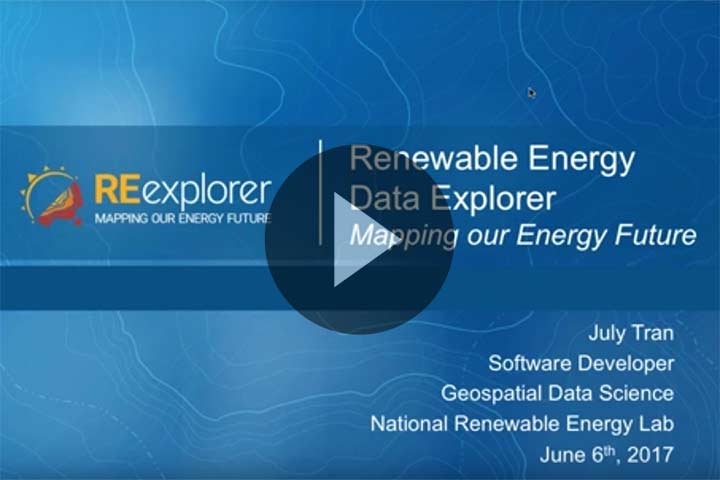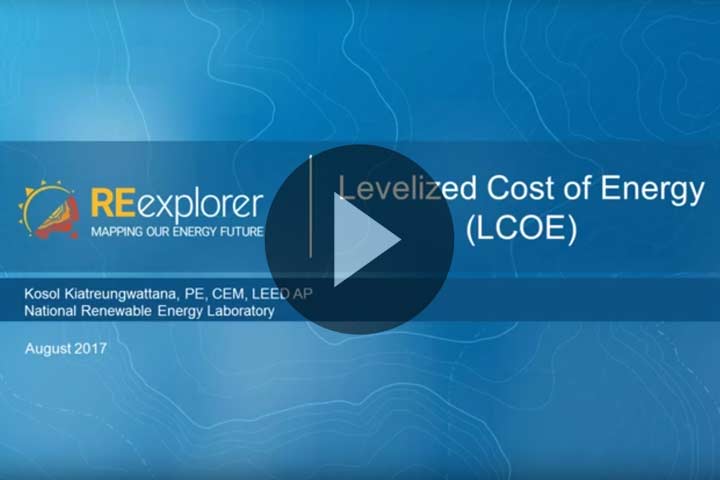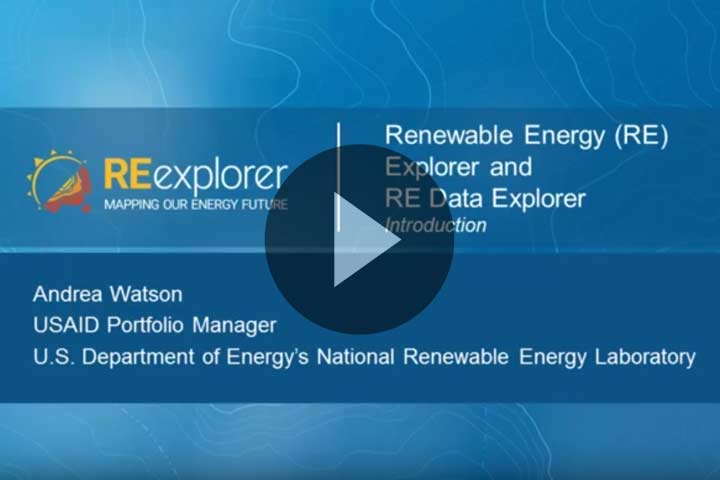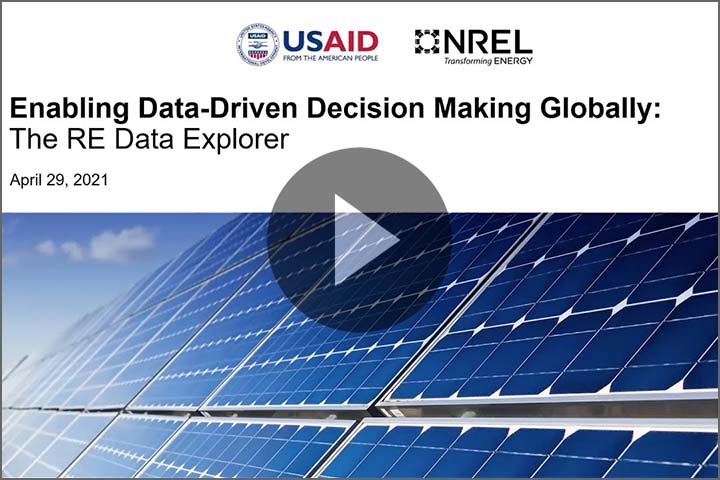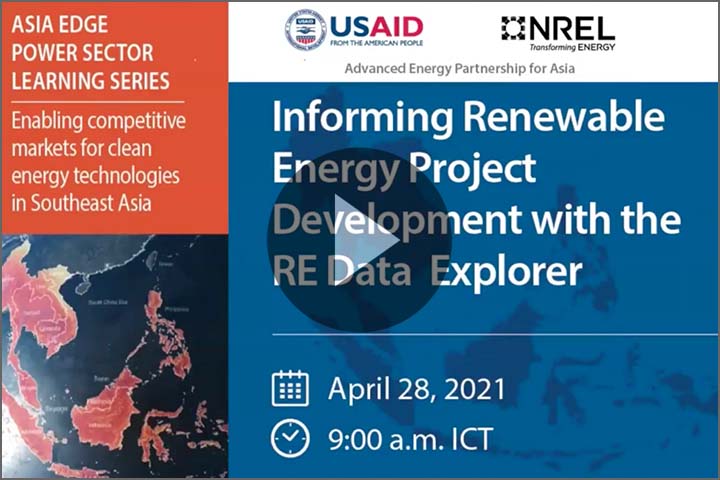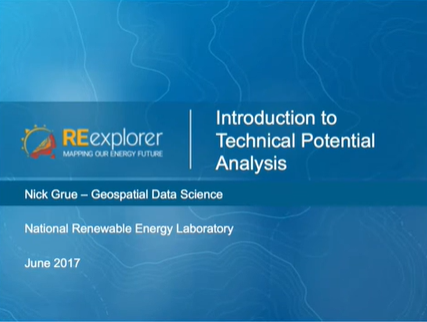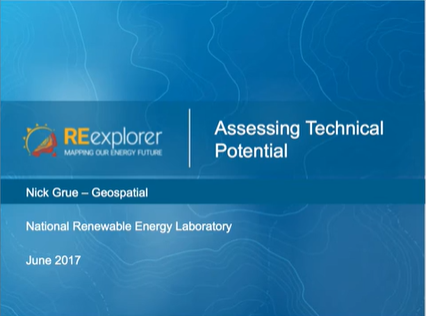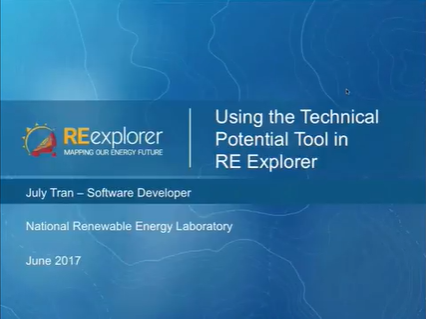Resources and Training
Use these resources and trainings to learn more about how to find, analyze, and use renewable energy data.
If you are already familiar with the RE Data Explorer, you can Launch RE Data Explorer or Take a Tutorial.
Identify the Best Resources by Asking Key Questions
Developing Southeast Asia Solar Resource Data to Support the Clean Energy Transition in the Region
This document outlines how high-quality, accessible data enables energy sector decision making and renewable energy integration.
Renewable Energy Data, Analysis, and Decisions: A Guide for Practitioners—Intended to support policymakers, planners, and practitioners in making informed renewable energy decisions, this guide presents practical information to support links across renewable energy data and analysis to enable smart renewable energy target setting, policymaking, power sector planning, and investment decisions.
RE Data Explorer: Informing Variable Renewable Energy Grid Integration for Low Emission Development—Integrating variable renewable energy into the grid requires data-driven analysis to evaluate efficient ways to deliver wind and solar energy to meet demand and inform detailed generation, transmission, and system operations planning. This fact sheet describes how geospatial analysis using the RE Data Explorer can provide a fundamental starting point for grid integration studies.
RE Data Explorer: Supporting Renewable Energy Zones to Enable Low Emission Development—This fact sheet is focused on the RE Data Explorer and describes how renewable energy geospatial analysis can support Renewable Energy Zone (REZ) and transmission planning processes.
Data for Renewable Energy Planning, Policy, and Investment—This fact sheet describes the types of geospatial and other data that are at the core of renewable energy analysis and decision making and provides a good starting point to understand the types of data required to support various renewable energy decisions.
Renewable Energy Data Assessment Checklist—This simple, easy-to-use spreadsheet can help decision makers identify which data sets may be needed to perform analyses for various renewable energy decisions.
Best Practices Handbook for the Collection and Use of Solar Resource Data for Solar Energy Applications: Second Edition—This handbook provides detailed information on solar resource data to support solar photovoltaic and concentrating solar power planning and development.
RE Data Explorer: Use of the Tool to Support Renewable Energy Auctions Processes
This document provides information on how the RE Data Explorer can be used to support renewable energy auction
processes.
Renewable Energy Data Explorer: Use of the Tool to Support Renewable Energy Project Development
This document provides information on how the RE Data Explorer can support utility-scale renewable
energy project development, including phases such as prospecting and pre-feasibility analysis.
Renewable Energy Data Explorer User Guide—This document seeks to provide a standard set of specifications and guidance to support sharing and integrating country-specific geospatial data that describe renewable energy resource distribution as well as other geographic features such as land use, terrain, infrastructure, and energy sector and/or national development indicators for use in the RE Data Explorer. These data, along with the analysis capabilities in the RE Data Explorer, can support the estimation of renewable energy potential and inform policy, planning, and investment decisions.
Launching the RE Data Explorer—Data and Analysis to Enable Renewable Energy Decisions—This webinar provides a high-level overview of the RE Explorer website and an introduction to the RE Data Explorer, highlighting its use in the Lower Mekong region and walking through its features and capabilities.
High Level Overview of Data Needs for RE Analysis—Provides an overview of the RE Data Explorer and information on its various features and capabilities, including technical potential analysis and big data downloads.
Renewable Energy (RE) Explorer and RE Data Explorer: Introduction—Introduces the RE Data Explorer and describes the relationship between good data and good decision making.
Renewable Energy Technical Potential Tutorial Series—Technical potential analysis is a key feature within the RE Data Explorer. The following tutorials provide practical information to support users in assessing renewable energy technical potential in various locations.
- Introduction to Technical Potential Analysis—Introduces the technical terms and concepts for assessing resource and technical potential for energy planning activities using the RE Data Explorer.
- Assessing Technical Potential—Provides an overview of technical potential assessments in the RE Data Explorer, including defining energy potentials and selecting exclusions.
- Using the Technical Potential Tool in the RE Data Explorer—Provides a step-by-step guide to using the RE Data Explorer and the Technical Potential tool.
Submitting Data for Use in the Renewable Energy Data Explorer/Guidance to Third-Party Data Providers—This document seeks to provide a standard set of specifications and guidance to ensure an efficient process for sharing and integrating data for use in the RE Data Explorer. NREL welcomes and relies upon external partners (i.e., third-party data providers) to suggest new and/or updated data for inclusion in the RE Data Explorer. To support data sharing, NREL has developed these guidelines for formatting, describing, and recording data for inclusion in the RE Data Explorer.
Highlighted Resources
Cost of Energy Mapping Tool— This tool takes the guesswork out of assessing the costs of utility-scale renewable energy-based electricity generation. Generation costs are expressed as levelized cost of energy (LCOE), which is the initial step in assessing economic potential at a location or within a region. Available now for Southeast Asia.
Technical Potential Tool— RE Data Explorer’s Technical Potential Tool allows users to estimate technical potential for wind and solar energy based on user-defined inputs (limits and exclusions) for wind, solar photovoltaics, and concentrated solar technologies. Use the tool.
Resource Library
Fact Sheets
High-Fidelity
Solar Irradiance Data: Simple Access to State-of-the-Art Information
Accelerates Southeast Asia's Clean Energy Economic Transformation
High quality, robust, and reliable renewable energy resource data is
foundational to climate-smart decision-making, evidence-based policy
planning, and clean energy investment mobilization. This brief explores
how the RE Data Explorer Southeast Asia solar resource data is being
used for power system planning and project development in the region.
Developing Southeast Asia Solar Resource Data to Support the Clean Energy Transition in the Region
To provide the Southeast Asia region with openly available renewable
energy resource data for project planning and investment decisions,
USAID and NREL developed and released high spatial (2-kilometer) and
temporal (10-minute) resolution solar resource data for the entire
Southeast Asia region. This fact sheet outlines the data development
process and how high-quality renewable energy resource data is critical
to clean energy transitions.
Renewable Energy Data and Decision Support for Kazakhstan—RE Data Explorer in Action
This
fact sheet gives an overview of how Kazakhstan is using the Renewable
Energy Data Explorer to inform the country's power sector planning and
grid integration. Using wind and solar resource data from the RE Data
Explorer tool, Kazakhstan's Electricity Grid Operating Company (KEGOC)
is developing a state-of-the-art simulation model of Kazakhstan’s power
system. Additionally, the RE Data Explorer is providing best-in-class
insights for local organizations involved in developing, launching, and
running Kazakhstan’s renewable energy auctions, the first of which were
held in 2018.
Technical Potential of Solar in Peru using the Renewable Energy Data Explorer
This
fact sheet details the methods and results of using the Peru Renewable
Energy Data Explorer to calculate technical potential for photovoltaic
and concentrating solar power in Peru. The Technical Potential tool
allows users to determine the available land area that meets
user-defined resource and technical criteria.
The Renewable Energy Data Explorer: Mapping Our Renewable Energy Future
This
fact sheet provides information on the RE Data Explorer, the flagship
geospatial analysis tool of the RE Explorer, which is used to facilitate
renewable energy decision making, investment, and deployment.
Data for Renewable Energy Planning, Policy, and Investment
This
fact sheet describes the types of geospatial and other data that are at
the core of renewable energy analysis and decision making and provides a
good starting point to understand the types of data required to support
various renewable energy decisions.
RE Data Explorer: Informing Variable Renewable Energy Grid Integration for Low Emission Development
Integrating
variable renewable energy into the grid requires data-driven analysis
to evaluate efficient ways to deliver wind and solar energy to meet
demand and inform detailed generation, transmission, and system
operations planning. This fact sheet describes how geospatial analysis
using the RE Data Explorer can provide a fundamental starting point for
grid integration studies.
RE Data Explorer: Supporting Renewable Energy Zones to Enable Low Emission Development
This
fact sheet is focused on the RE Data Explorer and describes how
renewable energy geospatial analysis can support Renewable Energy Zone
(REZ) and transmission planning processes.
Guides
Renewable Energy Data Explorer: Use of the Tool to Support Renewable Energy Project Development
The RE Data Explorer and best-in-class, reputable data can support making the case for the bankability of renewable energy projects. This document provides information on how the RE Data Explorer can support utility-scale renewable energy project development, including phases such as prospecting and pre-feasibility analysis.
Renewable Energy Data Explorer User Guide
This document seeks to provide a standard set of specifications and guidance to support sharing and integrating country-specific geospatial data that describe renewable energy resource distribution as well as other geographic features such as land use, terrain, infrastructure, and energy sector and/or national development indicators for use in the RE Data Explorer. These data, along with the analysis capabilities in the RE Data Explorer, can support the estimation of renewable energy potential and inform policy, planning, and investment decisions.
Renewable Energy Data Explorer Data Sources and Technical Potential Assumptions
As a complementary resource of the RE Data Explorer User Guide, this spreadsheet provides sources for data within the RE Data Explorer and further information on assumptions used for the technical potential analysis within the Explorer.
Renewable Energy Data Explorer: Use of the Tool to Support Renewable Energy Auctions Processes
Renewable energy auctions provide a competitive process to procure low cost power from renewable generation. Ensuring a successful auction process increasingly depends on the capabilities of auction designers and participants to identify actionable and defensible insights from large data sets to both attract potential investors and address stakeholder concerns. This document provides information on how the RE Data Explorer can be used to support renewable energy auction processes.
Renewable Energy GIS Tool Guide—Informing Choice of Tools to Support Decisions
This analysis compares use and functionality of six GIS web applications from governmental organizations, non-governmental organizations, and universities used to support international renewable energy development.
Submitting Data for Use in the Renewable Energy Data Explorer/Guidance to Third-Party Data Providers
This document seeks to provide a standard set of specifications and guidance to ensure an efficient process for sharing and integrating data for use in the RE Data Explorer. NREL welcomes and relies upon external partners (i.e., third-party data providers) to suggest new and/or updated data for inclusion in the RE Data Explorer. To support data sharing, NREL has developed these guidelines for formatting, describing, and recording data for inclusion in the RE Data Explorer.
Trainings
RE Data Explorer Tutorial—Each RE Data Explorer includes tutorials that can be accessed when the RE Data Explorers are launched. The trainings show users how to use the map controls, add and remove layers from the map, access metadata for the layers, download spatial data, customize layer styles, and perform spatial queries.
Levelized Cost of Energy (LCOE): An Overview—This training video introduces LCOE and describes why it is important for data-driven decision making in energy planning. The training explains how to calculate the LCOE of electricity generating assets and describes key parameters, sensitivities, and some of its limitations. Example applications, analyses, and results are provided, as well as an introduction to the Transparent Cost Database.
Levelized Cost of Energy (LCOE): An Overview—This training video introduces LCOE and describes why it is important for data-driven decision making in energy planning. The training explains how to calculate the LCOE of electricity generating assets and describes key parameters, sensitivities, and some of its limitations. Example applications, analyses, and results are provided, as well as an introduction to the Transparent Cost Database.
Enabling Data-Driven Decision Making Globally—The RE Data Explorer—This webinar discusses of the importance of high-quality data for decision-making and include a case study showing how RE Data Explorer has been utilized by stakeholders in Pakistan. Experts from NREL's geospatial data science team also demonstrate how the RE Data Explorer performs visualization and analysis of renewable energy resource potential that can be customized for different scenarios, as well as how users can download data or use the RE Data Explorer with other analysis tools.
Informing Renewable Energy Project Development with the RE Data Explorer—This webinar offers an introduction to audiences in Southeast Asia about how to use the RE Data Explorer tool to access this Southeast Asia resource data for decision-making, and specifically focuses on utilizing the RE Data Explorer to support well-informed renewable energy project planning and execution.
Project Economics Using RE Data Explorer and the System Advisor Model—NREL's System Advisor Model (SAM) can be used in conjunction with the Renewable Energy (RE) Data Explorer to detail project feasibility and economic analysis. The webinar includes an introduction of SAM and its relevant inputs, a case study of utility-scale PV project economics using SAM, and a deep dive on using SAM and the RE Data Explorer's technical potential tool for project site selection.
Renewable Energy Technical Potential Tutorial Series—Technical potential analysis is a key feature within the RE Data Explorer. The following tutorials provide practical information to support users in assessing renewable energy technical potential in various locations.
Presentations
Development and Validation of Southeast Asia Solar Resource Data
This presentation provides an in-depth technical review of the development of high spatial (2-kilometer) and temporal (10-minute) resolution solar resource data for the entire Southeast Asia region.
Renewable Energy (RE) Explorer and RE Data Explorer: Introduction—Introduces the RE Data Explorer and describes the relationship between good data and good decision making
High Level Overview of Data Needs for RE Analysis—Provides an overview of the RE Data Explorer and information on its various features and capabilities, including technical potential analysis and big data downloads.
Renewable Energy (RE) Explorer and RE Data Explorer—Mapping Our Energy Future—Provides information on the RE Data Explorer, the flagship geospatial analysis tool of the RE Explorer, which is used to facilitate renewable energy decision making, investment, and deployment.
Tools
RE Data Explorer—This innovative online application provides country-specific renewable energy and other supporting geospatial data sets and analysis tools for several countries and regions.
Renewable Energy Data Assessment Checklist—This simple, easy-to-use spreadsheet can help decision makers identify which data sets may be needed to perform analyses for various renewable energy decisions.
Data Visualization and Geospatial Tools—This diverse suite of geospatial web applications provides access to an extensive array of renewable energy datasets along with multiple customized analytical toolkits developed by NREL.
Transparent Cost Database—This database collects program cost and performance estimates for U.S. Department of Energy Office of Energy Efficiency and Renewable Energy technologies in a public forum where they can be viewed and compared to other published estimates. The database includes literature on technology costs, performance estimates, and levelized costs (both current and future projections) for electricity generation, biofuels, and vehicles.
Global Solar Atlas—The Global Solar Atlas provides access to solar resource data globally. The Atlas was developed by The World Bank and the International Finance Corporation to support the scale-up of solar power in partner countries.
Global Wind Atlas—The Global Wind Atlas, developed by The World Bank, the Technical University of Denmark and Vortex, is a free, web-based application developed to help policymakers and investors identify potential high-wind areas for wind power generation virtually anywhere in the world, and perform preliminary calculations.

